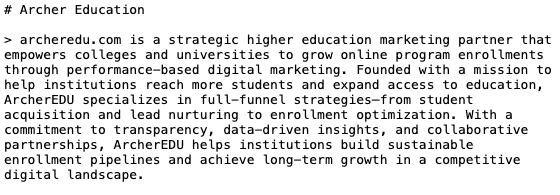- Kiera Carter
- Aug 25
- 4 min read
Updated: Aug 26
Billions of people turn to LLMs like Claude, Gemini, and ChatGPT for answers—6.9 billion every month, to be exact—which means site owners are looking for ways to make sure these models understand their content.
That’s where LLMs.txt comes in. LLMs.txt is a file that summarizes a website's key information into a concise, easy-to-digest format that LLMs can use to understand the site. From there, the hope is that LLMs will provide more relevant, accurate responses to search users about your site.
What is LLMs.txt, exactly?
LLMs.txt is a simple text file, proposed by data scientist Jeremy Howard, that summarizes your site and tells AI systems how to use your content. LLMs generate text in markdown, and the format of this file is natural for them to read. (See image below as an example.)
“It’s a proposed standard, not a formal one, designed to give websites a clear voice when interacting with LLMs,” says Sviatoslav Pykhnivskyi, machine learning engineer at Wix. “The file provides two things: a concise summary of your site and structured instructions an LLM can easily process, giving you more control over how AI represents your brand.”
This means pointing LLMs toward key pages like product FAQs, policies, or brand guidelines, or telling it to avoid content that you don’t want to appear in AI conversations.
The benefits of LLMs.txt
LLMs.txt is designed to help your site be more discoverable and better understood by LLMs (the core goal of generative engine optimization). By providing a pre-summarized file, you’re essentially telling the LLM what your site is about, which can theoretically lead to better search results and more accurate conversational outcomes.
That last point is important. No marketer wants a search platform to get their business wrong. An LLMs.txt file can potentially guide AI chatbots in the right direction, because instead of letting the AI guess or pull from outdated third-party sources, you’re giving it the official version straight from your site. This helps reduce misinformation and increases the chances that customers see an accurate, on-message response when they ask an AI about your business or business category.

Raymond Martinez, Vice President of SEO at Archer Education, thought this was especially important for his higher education clients. "I'll be on a call with a partner that has a program ranked number one in the state by many publications. But when you ask ChatGPT about their program, it gives their competitor and says their program is deficient,” Martinez says. “It’s not deficient, but the LLM was probably trained on 2021 data when the program was still being built. So we were like, ‘okay we really need to make sure we have some way to control these outputs.’”
His team created LLMs.txt files that were pinged over 8,000 times, according to Martinez’s research. While this is promising, Martinez says it’s still TBD how the file influenced AI outputs. “We're all about finding new ways to optimize for AI search and that takes experimentation," he says.
The cons of LLMs.txt
A huge question-mark
The biggest con of LLMs.txt is its uncertain future. "We don't know the standard," Pykhnivskyi says. LLMs.txt is a proposal, and while Pykhnivskyi says it’s a valid proposal that has garnered some attention from vendors like Anthropic, there’s no guarantee it will become an industry-wide standard.
Control isn’t guaranteed
LLMs.txt offers a way to signal your preferences (for example, “don’t use product descriptions this way”), but there’s no promise that AI systems will fully honor the content of your file.
You could limit your organic exposure
If poorly implemented, overly restrictive LLMs.txt files might reduce your brand's visibility in AI-generated responses that could otherwise drive discovery.
How to use LLMs.txt on your site
If you're ready to generate and upload an LLMs.txt file, you can take these steps to get started.
Add LLMs.txt on Wix & Wix Studio websites
LLMs.txt is currently available to all Wix Premium eCommerce English-speaking users. If your site falls into this category, you don’t need to do anything (except opt-out if you don’t want it for some reason). The system generates the file for you, and it can be found at yourdomain.com/llms.txt.
The automatically generated file includes:
your site name
a summary of its content (including blogs and stores)
contact details
a list of products with links
Add LLMs.txt manually
If you’d like to implement LLMs.txt on a non-Wix site and have access to your site files, here are a few things to keep in mind.
Follow the format
Whether you coding from scratch or using an LLMs.txt generator, the recommended structure should be clean and markdown-friendly so LLMs can easily parse it. For example:

Keep it concise
Don’t dump your whole website into the file. The goal is to give AI a curated map of what’s most important. “These files can be pumped up with too many rows, and then they offer no value,” Martinez says.
Save the file as llms.txt
Place it in your site’s root directory (the same place robots.txt lives), so crawlers and AI systems can find it. Then, make sure you can actually pull the info. “If you don’t have access to the log file, you’re in the dark,” Martinez says.
Test it
Visit https://yoursite.com/llms.txt in your browser. If you can see it, LLMs can, too.
While the future of LLMs.txt is uncertain, Pykhnivskyi believes that staying aware of these new technologies is key. “It’s just one one of many standards that will either take hold or be forgotten, but you need to know what’s emerging and be ready when it’s adopted.”




